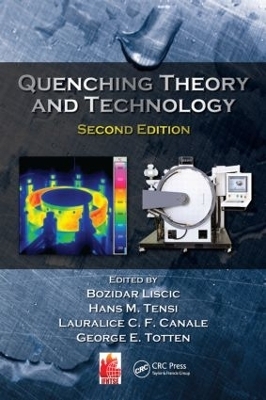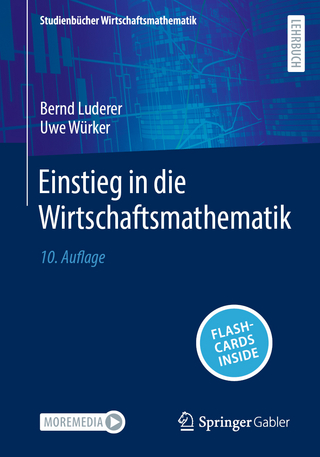
Quenching Theory and Technology
Crc Press Inc (Verlag)
978-0-8493-9279-5 (ISBN)
Quenching is one of the most fundamentally complex processes in the heat treatment of metals, and it is something on which mechanical properties and distortion of engineering components depend. With chapters written by the most respected international experts in the field, Quenching Theory and Technology, Second Edition presents the most authoritative, exhaustive, and recent findings in this vital area. Understanding and control of quenching and quenchants is a critical constant in all well established and emerging heat treatment process technology. The collection of up-to-date knowledge in this book is the latest outcome from continuing formal and informal discussions by experts within the framework of the International Federation for Heat Treatment and Surface Engineering (IFHTSE).
It covers topics including:
Thermo-and fluid dynamic principles of heat transfer during cooling
Wetting kinematics
Residual stresses after cooling
Computer modeling and prediction of microstructure transformation
Hardness distribution
Stress-strain and distortion
With revised and updated content from the first edition, this book adds coverage of important technological developments. Although the primary focus continues to be on the quenching of steel, it also details quenching of aluminum and titanium alloys, quench severity of selected vegetable oils, gas quenching, intensive quenching, and simulation of quenching. Presenting the most recent findings in this area, this essential piece of literature is a substantial contribution to the general field of the thermal processing of metals. It is useful not only for specialists in heat treatment practice, but also those in higher education or numerous specialized courses and seminars worldwide.
Božidar Liščić received his BS in Mech. Engineering (1954) from the University of Zagreb (Croatia), and his Ph.D.in Material Science (1975) from the same university. He is a full professor (retired) of the Faculty for Mechanical Engineering and Naval Architecture the University of Zagreb. From 1971-1990 he served as UNDP Expert for Heat Treatment in: Israel, India, Egypt, Turkey, Bangladesh and Pakistan. Prof. Liščić is past-president of the International Federation for Heat Treatment and Surface Engineering (IFHTSE), and a Fellow of ASM International. From 2003 to 2008 he was member of the Standing Committee for Physical and Engineering Sciences of the European Science Foundation (ESF). He is a Founding member of the ASM-Heat Treating Society, and a Full member of the Croatian Academy of Sciences and Arts. Prof. Liščić is author or coauthor of over 100 publications, and contributed to the following books: Technologie der Wärmebehandlung von Stahl, Theory and Technology of Quenching (editor), Steel Heat Treatment Handbook, and Steel Heat Treatment Handbook-Second Edition- Metallurgy and Technologies. George E. Totten, Ph.D. is President of G.E. Totten & Associates, LLC in Seattle, Washington and a visiting professor of Mechanical and Materials Engineering at Portland State University, Portland, OR, USA. Dr. Totten is co-editor of a number of books including Steel Heat Treatment Handbook, Handbook of Aluminum, Handbook of Hydraulic Fluid Technology, Mechanical Tribology, and Surface Modification and Mechanisms (all titles of CRC Press), as well as the author or coauthor of over 500 technical papers, patents and books on lubrication, hydraulics and thermal processing. Dr. Totten is a Fellow of ASM International, SAE International, the International Federation for Heat Treatment and Surface Engineering (IFHTSE) and the American Society for Testing and Materials International (ASTM). He is also a member of other professional organizations including: ACS, ASME, STLE, and ASTM. Dr. Totten formerly served as president of IFHTSE. He received the BS and MS degrees from Fairleigh Dickinson University. Teaneck, New Jersey and the Ph.D. degree from New York University, New York. Lauralice C. F. Canale is an associate professor at the University of São Paulo (Brazil) where she is responsible for Heat Treatment, Tribology and Science and Materials Engineering courses. Prof. Canale received her MS degree and PhD degrees in mechanical engineering from the same university and conducted Post Doctoral research at the University of Tennessee (USA). Prof. Canale is a co-editor of 3 books: Failure Analysis of Heat Treated Steel Components (ASM), Theory and Technology of Quenching. 2nd edition (CRC) and a commemorative book "15 Anos do Programa de Post-Graduação em Ciência e Engenharia de Materiais" (EESC/USP). She is an author or co-author of 9 chapters (ASM and CRC books) and over 140 technical papers. She has received various awards and citations and recently received the Fellow of IFHTSE award.
Hardening of Steels. Quenching of Aluminum Alloys. Quenching of Titanium Alloys. Mechanical Properties of Ferrous and Nonferrous Alloys after Quenching. Thermo- and Fluid-Dynamic Principles of Heat Transfer during Cooling. Heat Transfer during Cooling of Heated Metals with Vaporizable Liquids. Wetting Kinematics. Wetting Kinetics and Quench Severity of Selected Vegetable Oils for Heat Treatment. Residual Stresses after Quenching. Effect of Workpiece Surface Properties on Cooling Behavior. Determination of Quenching Power of Various Fluids. Types of Cooling Media and Their Properties. Gas Quenching. Techniques of Quenching. Intensive Steel Quenching Methods. Prediction of Hardness Profi le in Workpiece Based on Characteristic Cooling Parameters and Material Behavior during Cooling. Simulation of Quenching. Appendices. Index.
| Erscheint lt. Verlag | 27.7.2010 |
|---|---|
| Zusatzinfo | 97 Tables, black and white; 481 Illustrations, black and white |
| Verlagsort | Bosa Roca |
| Sprache | englisch |
| Maße | 178 x 254 mm |
| Gewicht | 1542 g |
| Themenwelt | Mathematik / Informatik ► Mathematik ► Angewandte Mathematik |
| Technik ► Elektrotechnik / Energietechnik | |
| Technik ► Maschinenbau | |
| Technik ► Umwelttechnik / Biotechnologie | |
| ISBN-10 | 0-8493-9279-9 / 0849392799 |
| ISBN-13 | 978-0-8493-9279-5 / 9780849392795 |
| Zustand | Neuware |
| Haben Sie eine Frage zum Produkt? |
aus dem Bereich


